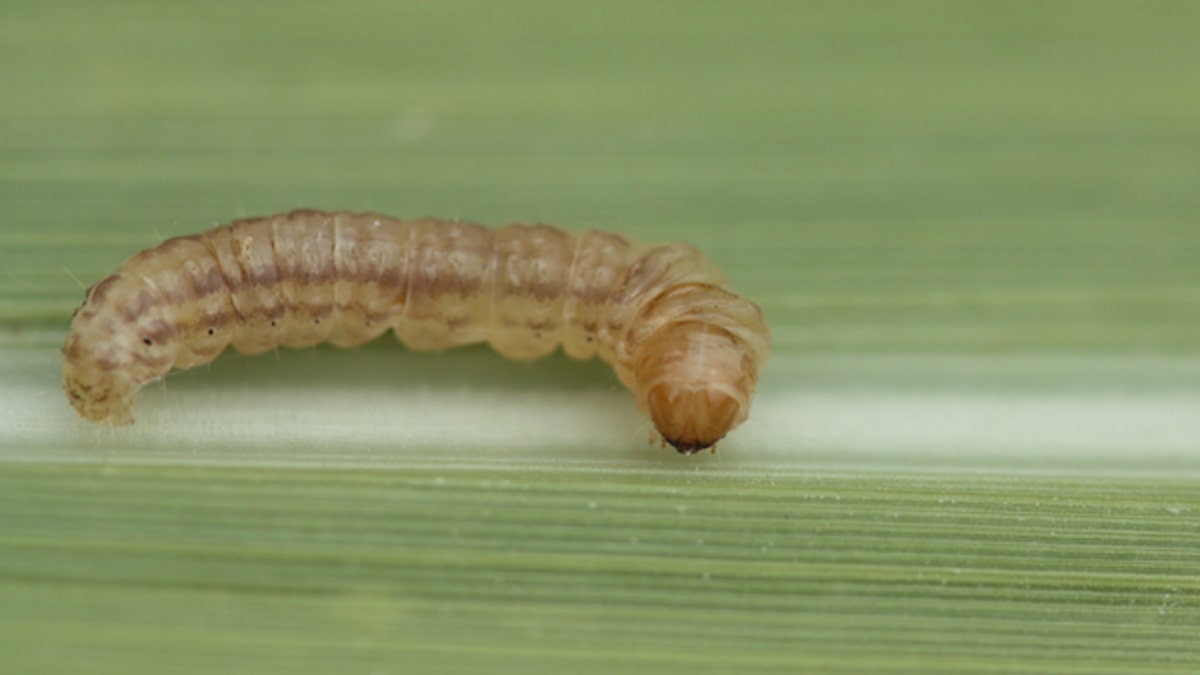
Mexican rice borer is seen on a sugarcane leaf. (LSU Agricultural Center)
NEW ORLEANS – Mexican rice borers have crawled into southwestern Louisiana rice plants and are heading for the nation's sugar bowl, where the inch-long moth grubs are a much bigger threat.
Although they can do serious damage in rice fields, crawling in and out of the narrow stalks leaves the caterpillars vulnerable to pesticides, while fat sugar canes give them permanent shelter, LSU Agricultural Center entomologist Gene Reagan said.
Louisiana grows about 40 percent of the nation's sugar, with another 45 percent or more grown in Florida. It's the nation's third-biggest rice-growing state, behind Arkansas and California.
The one Louisiana rice paddy where Mexican rice borers have been found so far was near Vinton, though they probably are in others, AgCenter rice expert Johnny Saichuk said Tuesday.
"It causes what farmers call a whitehead. ... Grains are blanked out because there's no nutrients being carried up" the injured stem, he said.
He said the Vinton-area farmer had planted his other rice fields with insecticide-treated seeds, and they were fine. The infested field is one where he raises crawfish after harvesting rice, Saichuk said. To keep from poisoning his crawfish, he used untreated seed.
As the moth's range expands, it will become a problem for more farmers who rotate rice and crawfish, Saichuk said -- though even before its arrival, "the marriage between rice and crawfish production turned out not to be as good as people first envisioned."
The grubs, which hatch into brown moths about a half-inch to three-quarters of an inch long, eat a wide variety of grains and grasses.
U.S. entomologists found them in Arizona in 1917 and in California in the 1920s. But the threat to Louisiana's sugar became apparent in the 1980s, when they reached some experimental sugarcane fields in Texas, Reagan said.
Reagan went to some of those farms. At that time, farmers still set fire to their fields just before harvest to burn the leaves from the stalks.
"There were more than a few fields that the farmers could not harvest at all. There was nothing to carry to the mill. They'd try to burn the trash and the field would just completely burn up," he said.
Reagan said it will probably take them another year or so to reach commercial sugarcane fields in Louisiana.
He and Texas A&M entomologist M.O. "Mo" Way have been studying ways to control the bug in sugarcane since the 1980s. Their list is topped by irrigation. Though the moths lay eggs on some green foliage in rice, "on sugarcane we've never found them on anything but brown and dying foliage," Reagan said.
Many pests tend to lay more eggs in stressed plants, and dry sugarcane leaves provide extra protection from weather and predators, he said: as the leaves wilt they fold, and eggs touch both sides of the fold.
Because Louisiana gets more rain than the Rio Grande Valley, the cane may be less attractive to the moths, he said. Agronomists also have been working to breed varieties of sugarcane that are resistant to the grubs -- and one of Reagan's students recently worked out why pesticides don't control the rice borer well in sugarcane. "The insect goes into the plant very quickly" after hatching, Reagan said.
He said the student, Blake Wilson, also has been working on how to time the pesticide. When traps baited with the sex attractant of female moths catch 20 to 25 male moths a week, pesticide residue is likely to poison the grubs as they hatch, he said.
All of that research has been done in the Rio Grande Valley and Beaumont areas. "We wouldn't even think of studying the live insect here at LSU until the insect is already here," he said.
"We've learned a lot about the ways we're going to try to manage the insect and get ready for it."

